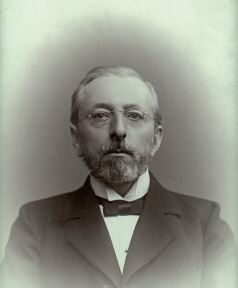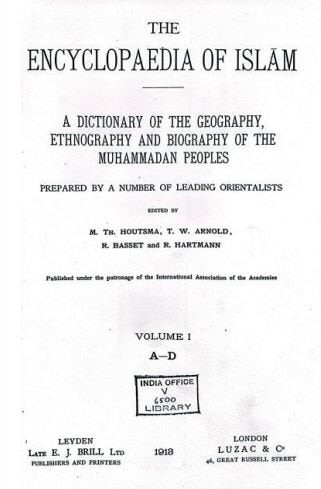Tahmeed Ahmad, Ahmadiyya Archive & Research Centre (ARC)
In today’s age of endless information, a simple online search about the “Ahmadiyya Muslim Jamaat” will provide plenty of information about the Community. However, over a hundred years ago, information was harder to come by and news was spread through paper and books. Despite this, the small community of Qadian, in British India, with its white minaret, was attracting attention from around the world due to the efforts of Hazrat Mirza Ghulam Ahmadas and his message.
The Ahmadiyya Archive and Research Center (ARC) is publishing a series on some of the earliest publicly available information on the community from various orientalists, highlighting its reach and the important work being done in its early years.
Martijn Theodoor Houtsma

The first orientalist is Professor Martijn Theodoor Houtsma, a Dutch professor at the University of Utrecht. He remains best known for his work on The Encyclopædia of Islam and A Dictionary of the Geography, Ethnography and Biography of the Muhammadan Peoples. The encyclopaedia was his magnum opus and to complete it, Mr Houtsma required information on one of the most captivating Muslim communities at the time: Jamaat-e-Ahmadiyya. How he acquired that information is best explained in his own words, originally written in French:
“Revue du Monde Musulman
“‘The Ahmadiyya Religious Movement in British India’
“The following memorandum on the Ahmadiyya Religious Movement was sent to me for The Encyclopædia of Islam, which is currently in print. I had requested the editors of The Review of Religions – the official organ, so to speak, of the Ahmadiyya – to send me a brief outline of their beliefs, and Mr Denison Ross, Principal of the Calcutta Madrasa, had kindly seconded this request to Prophet Mirza Ghulam Ahmad Qadiyani, for which I wish to express my thanks to him here. The manuscript that was sent to me in this way went far beyond the limits of an encyclopaedic dictionary article, so I offered it to the Revue du Monde Musulman. Can one only know the present Muslim world by listening to the Muslims themselves? The readers of the Review will be grateful, as I am, for having taken on this publication.
“Not much is known in Europe about the Ahmadiyya movement. Only, I believe, Mr T-W Arnold spoke of it in a paper given at the 12th International Congress of Orientalists in Rome in 1899.
“Then, as I have just indicated, the Ahmadiyya themselves publish an English journal, which appears every month in Qadian in the Punjab, under the title of The Review of Religions. I have before me the fourth volume, published in 1905. It contains several very interesting articles, but this Review is hardly known in Europe. Perhaps one might still find an article on the Ahmadiyya in some English missionary publication, but one should not expect to find in the works of this order an impartial study of a Muslim sect.
“I have not thought it proper to dwell here on the opinions of the Ahmadiyya, nor to add any comments or notes to the views so clearly expressed by our Muslim author. If I do not know his name, I can guarantee that he belongs to the immediate entourage of the Prophet of Qadian.
“Mr Th. Houtsma,
“Professor at the University of Utrecht”
The above-mentioned text mentions a manuscript sent by the community to the professor. However, for the time being, the manuscript would be too lengthy of an item to add and will be published on a different occasion in the near future.
Another point mentioned by the professor is the fourth volume of The Review of Religions he was gifted. It should be noted that an extract of the professor’s text has been reproduced in the first issues of The Review of Religions’ fifth volume:
“Professor M H Houts, MA, [Houtsma]
“(Professor of the University of Utrecht in Holland, and Editor-in-Chief of the Encyclopaedia of Islam)
“Further I beg to express my most sincere thanks for the fourth volume of the Review of Religions which you had the kindness to forward to me. The contents appear to me to be extremely interesting.” (The Review of Religions, Vol. 5, January 1906, p. 6)

The Encyclopaedia of Islam
At last, it begs the question, what was written about the Ahmadiyya Muslim Community in The Encyclopædia of Islam? To answers this question, we have transcribed the original text for the benefit of our readers:
“AHMEDIYA is the name of the adherents of Mirza Ghulam Ahmed Kadiani (of Kadian, district of Gurdaspur in the Pandjab.) In 1900 they were with their own approval entered under that name on the official census lists of the Indian Government, as a separate modern Mohammedan sect. The Ahmedis are especially numerous in the Punjab, but also in other provinces of the Presidency of Bombay and elsewhere in India. They are found besides in other Mohammedan countries such as Afghanistan, Persia, Arabia, Egypt etc. Their number is gradually increasing in consequence of zealous propagandism. Their principal organ is The Review of Religions, written in English, which since 1902 has been published regularly once a month at Kadian. But they also make use of various other papers in Indian languages, weeklies, monthlies and quarterlies. They have also separate extensive writings, amongst which Barahin-i Ahmediya (The Arguments of the Ahmediya), written by the founder Mirza Ahmed, is the most important. The first volume of this work appeared in 1880, and in it, the author claimed the dignity of a Mahdi, though not until March 4th 1889 did he demand the homage of his adherents.
“The doctrines of the Ahmediya agree on the whole with those generally taught by the Islam. The most striking differences concern only Christology, the vocation of the Mahdi and the djihad (the holy war). As to the first mentioned doctrine, they assume that Jesus did not die on the cross, but after his apparent death and resurrection migrated to India, strictly speaking to Kashmir, in order to preach the gospel in that country. There he is said to have died at the age of 120 years; his tomb at Srinagar is still known, but is mistaken for that of a prophet called Yuz Asaf (which according to the Ahmedis must not be explained as a corruption of Bodhisattva). At the instigation of a certain Mawla Mahammed Husain a fatwa against Mirza Ahmed was published in India, purporting that this doctrine disagreed with the Kor’an and therefore had to be looked upon as heresy. Regarding the vocation of the Mahdi and djihad the Ahmediya teach, that the task of the former is one of peace, and that the djihad against the unfaithful must be conducted with peaceful means instead of instruments of war. Under all circumstances, sincere obedience must be given to the British Government. The Mahdi himself must be considered an incarnation of both Jesus and Muhammed. To believe in him is an article of faith, because first of all his coming early in the 14th century of the Hidjra was predicted by Muhammed, and secondly, because he proved his divine vocation by his prophetic gift. On various occasions this gift has manifested itself: not only the terrible destructions caused by pestilence and earthquake during the last decades, but also the death of certain people are said to have been prophesied by him. When one of his last-mentioned predictions came true through the murder of an inhabitant of Lahore, Mirza Ahmed was accused of the crime by three Christian missionaries, but acquitted in court.
“Since the Mahdi (who died in 1908) resigned his leadership because of old age, the affairs of the Ahmediya have been conducted by the Sadr Andjuman-i Ahmediya.
“Bibliography: T. M. Arnold, Actes du XII congrès internat. des Orientalister (Rome, 1899) iii. 1, p. 139 et seq.; Richter, Indische Missionsgeschichte; M. Th. Houtsma, in the Revue du monde musulman i. 333 et seq. (derived from information supplied by the Ahmedis themselves). (M TH HOUTSMA)”

The call to Islam
يٰۤاَيُّهَا الرَّسُوۡلُ بَلِّغۡ مَاۤ اُنۡزِلَ اِلَيۡكَ مِنۡ رَّبِّكَ ؕ وَاِنۡ لَّمۡ تَفۡعَلۡ فَمَا بَلَّغۡتَ رِسَالَتَهٗ ؕ وَاللّٰهُ يَعۡصِمُكَ مِنَ النَّاسِ ؕ اِنَّ اللّٰهَ لَا يَهۡدِي الۡقَوۡمَ الۡكٰفِرِيۡنَ
“O Messenger! convey [to the people] what has been revealed to thee from thy Lord; and if thou do it not, thou hast not conveyed His Message [at all]. And Allah will protect thee from men. Surely, Allah guides not the disbelieving people.” (Surah Al-Ma’idah, Ch.5: V.68)
This concludes the first of many reports written on the Ahmadiyya Muslim Community. We saw firsthand how Allah the Almighty moves mountains and rivers for the benefit of his prophets. This was the story of Mr Martijn Theodoor Houtsma and how he, through the blessings of Allah the Almighty, helped spread the message of the Promised Messiahas to countless others.

